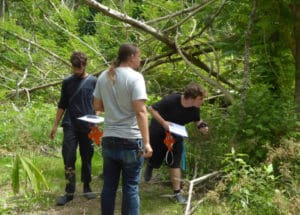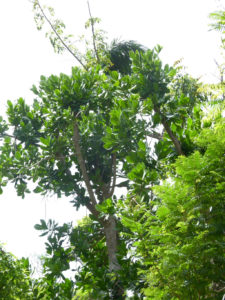
What a few short months ago was a muted haven for exotic trees gracefully sharing the fecund forest floor with invasive and native species alike is today a tangled, nearly impenetrable crush of mammoth felled trunks, dead leaves still clinging to their broken branches. The softly trodden paths that once wove through and around the trees, providing breathing room for all living things that found themselves enveloped in the dewy quiet, have disappeared under the detritus of disaster. Only the tenacious underbrush, tenuously connected by whispery spider webs, suggests that life goes on blissfully unconcerned with the losses surrounding it.
Climbing over , crawling under and sometimes just pushing through the jumble of the living and the dead who are guarded by ankle-grabbing vines, it is impossible to see in the mind’s eye what the Alphonso Nelthropp Arboretum at Magens Bay once was and even more difficult to imagine what it might become.
On Friday, a determined trio of University of the Virgin Islands graduate students began the arduous undertaking of surveying what is left so that what the future could hold might be articulated for the people tasked with bringing the arboretum back to the community of wildlife and nature lovers who have come to depend upon it for habitation and solace.
“Volunteachism,” is what what Antonio Farchette called the task he and his cohorts were embarking upon, thanks to their professor Renata Platenberg. “It’s our class project,” Farchette said Friday afternoon.
They were armed only with a faded copy of a hand drawing of the arboretum from 1990, with names and locations of very particular non-indigenous trees noted. It has been sketched by local tree expert Toni Thomas. With that in hand, Farchette, Owen Clower and Manu Afshar clawed and heaved their way through the brambles searching for remains of legacy trees planted in the early part of the 20th century by Swiss industrialist Arthur Fairchild.
Fairchild was aided and guided by arboretum namesake Nelthropp, whose vast botanical expertise was put to work in creating Fairchild’s tropical fantasy. The work was created on the 50-plus acres Fairchild had begun to acquire 100 years ago as the former Danish colony was beginning its new life under the United State flag. Fairchild, who had gathered the seeds and cuttings for the trees from across the globe to place in his garden a thousand feet from Magens Bay, eventually deeded the property to the people of the Virgin Islands and the oversight was placed with the autonomous Magens Bay Authority.
Sadly, none of Friday’s three-member team had seen the arboretum before Hurricanes Irma and Maria had carried out their destruction.
But it was clear, as the St. Croix born and raised Farchette said, “It definitely got smashed.”
Afshar unabashedly expressed his feelings of grief at the loss before him, sighing and shaking his head as more and more of the destruction became apparent. But he found hope and reason in the sorrow.
“The more we are in touch with those feelings, the more we can respect nature and our connection with it.”
In fairness, he already knew all was not lost. Afshar, had conducted his own survey prior to Friday and was happy to report, “I’ve seen the Gri Gri. It’s perfect.”

The Gri Gri, also known as the Black Olive tree, was indeed perfect. Shiny, vibrant leaves were abundant and reflecting light from the sun as the branches stretched above what little canopy was left, rendering the Gri Gri a beacon of highly visible hope above and beyond the barricade of broken-ness that seemed to otherwise be everywhere.
A rustling sound in the crunchy dry brush heralded Platenburg’s arrival. Her passion for the wildlife is evident to anyone who knows the red-haired, straight-speaking woman who has guided a couple of generations of students through the master in marine science program at UVI.
“We are here to identify what happened,” she said, “in the interest of presenting alternative thoughts on how to proceed.”
Discovering and recording which trees are vulnerable, which trees came up by the roots and which ones are still standing is the task ahead for the students.
Of the dozen trees Thomas meticulously located in 1990, it is impossible to say how many might not have survived Hurricane Marilyn four years later. For those not versed in tree-ology, exotic trees are not that easy to distinguish from the more ordinary – especially without their flowers.
For example, what Afshar excitedly believed could be the Copper Pod tree, native to south east Asia and identified in 1990 as still being alive and well, Plantenburg said after seeing a photo of it was probably a local Almond tree.
On Sunday, as a second expedition into the tangled forest began, this time to identify and carefully mark trees for removal, Clower said Friday’s group was confident they had found and identified eight Fairchild legacy trees.
Platenberg understands the value of these aged aliens, but hopes that going forward indigenous species will find their way back to the wetlands where they came from and where they will be supported naturally.
Surveying the vast bowl of green, untouched hillsides that embrace Fairchild’s gift, defending it from the invasion of bulldozers and cement that have longed to creep their way into the protected park, Platenburg notes that the hills form a vast watershed.
After the storm, she struggled her way into the park to set the detection devices she uses to monitor the activity of the frogs and bats that inhabit the 318-acre nature preserve.
“The water was up to here,” she said holding her left hand midway up her thigh.
“Some people believe this whole area was once a pond,” she said, referring to the flat lands at the bottom of the steep small mountains that form the protective bowl.
For anyone who has walked the nature trail that winds its way a couple of miles up the sides of the steep hills, the pond theory would be more than plausible. To wit, a boardwalk had to be constructed for hikers to use, lest they sink into the sodden muck to the east of the arboretum. That portion becomes a swamp with the slightest rainfall. The boardwalk was completed in 2004, two years after the Nature Conservancy in partnership with the Virgin Islands government secured the final 228 acres that will keep the park forever a safe habitat for birds, lizards, blue crabs and deer along with Plantenburg’s frogs and bats. It was destroyed in the storms.
But thanks to the efforts of the Conservancy and some local friends of Magens, the trail is negotiable, according to MBA board member Robert Moron. Eventually he expects the narrow wooden walkway will be rebuilt, Moron said after a board meeting Friday.
Between the Magens board, Plantenburg, and other deeply committed community members, the new plan for the arboretum as it develops is likely to be well thought-out and implemented in a way that honors Fairchild’s gift while respecting nature’s realities.
If that is done, many years from now future generations will never have to know what was lost. They will be gifted only with what has been preserved and endowed to them.





